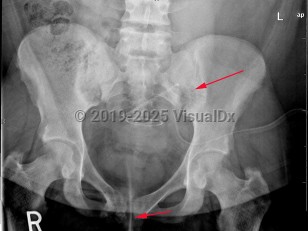Primary hyperparathyroidism
Alerts and Notices
Important News & Links
Synopsis

Secondary hyperparathyroidism is the consequence of another underlying condition that generally causes low levels of circulating calcium, resulting in the parathyroid glands' subsequent hyperfunction. Common etiologies of secondary hyperparathyroidism include chronic renal disease, severe vitamin D deficiency, and severe calcium deficiency.
High-risk populations include postmenopausal women and patients who have had chronic and serious calcium or vitamin D deficiency, have a rare genetic disease, have undergone radiation therapy, or have taken lithium.
The disorder is most prevalent in individuals aged 50-60 years. Females are more frequently affected.
Patients are usually asymptomatic. Asymptomatic patients with incidentally discovered PHPT may have measurable end-organ manifestations, such as nephrocalcinosis, hypercalciuria, decreased cortical bone mineral density, and reduced creatinine clearance. Symptomatic patients have variable presentations. In mild cases, common symptoms include fatigue, lethargy, depression, muscle weakness, and muscle pain. In severe cases, symptoms include anorexia, nausea, vomiting, constipation, confusion, memory impairment, frequent urination, and bone thinning and fractures. Sustained hyperparathyroidism can lead to osteitis fibrosa cystica, forming cystlike tumors in the bones.
Complications are dependent on the long-term effects of insufficient calcium in a patient's bones and excessive calcium circulating in the bloodstream. Common complications include osteoporosis, kidney stones, cardiovascular disease, and hypoparathyroidism of the neonate in pregnant individuals with untreated hyperparathyroidism.
Treatment is dependent on the course of the disease and will vary depending on individual cases. Patients who are asymptomatic may not require any treatment and should be closely monitored by their physicians. Medications such as bisphosphonates may help with bone health, and estrogen therapy may benefit postmenopausal women. Patients with PHPT due to familial hypocalciuric hypercalcemia may need parathyroidectomies.
Codes
E21.0 – Primary hyperparathyroidism
SNOMEDCT:
237653008 – Familial primary hyperparathyroidism
36348003 – Primary hyperparathyroidism
Look For
Subscription Required
Diagnostic Pearls
Subscription Required
Differential Diagnosis & Pitfalls

Subscription Required
Best Tests
Subscription Required
Management Pearls
Subscription Required
Therapy
Subscription Required
Drug Reaction Data
Subscription Required
References
Subscription Required
Last Updated:04/08/2024

